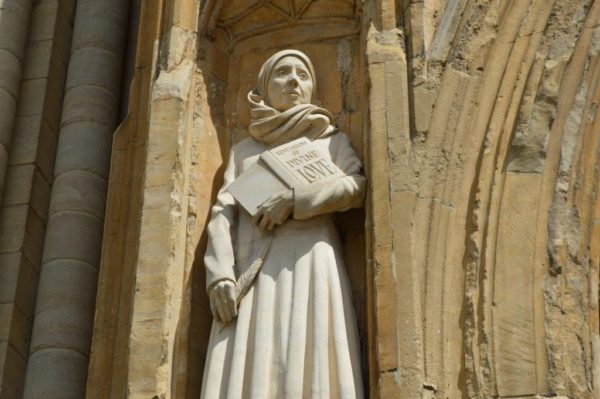 Julian of Norwich (circa 1342-1416) was an English anchoress, a mystic and theologian. She authored the first book written in English by a woman, based on visions she had received when she was very ill and near death. She lived in a two-room anchorite cell, attached to the Church of St. Julian in Norwich, the second largest city in England at the time. She had a window overlooking the church altar so that she could participate in Mass and receive communion. In addition, she counseled visitors who came to visit her, including Margery Kempe, a contemporary pilgrim laywoman who wrote her own book, thought to be the first autobiography written in the English language.
Julian of Norwich (circa 1342-1416) was an English anchoress, a mystic and theologian. She authored the first book written in English by a woman, based on visions she had received when she was very ill and near death. She lived in a two-room anchorite cell, attached to the Church of St. Julian in Norwich, the second largest city in England at the time. She had a window overlooking the church altar so that she could participate in Mass and receive communion. In addition, she counseled visitors who came to visit her, including Margery Kempe, a contemporary pilgrim laywoman who wrote her own book, thought to be the first autobiography written in the English language.
We don’t know much about Julian’s early life, but it is likely that she was educated by the Benedictine nuns who lived nearby in Carrow. Because St. Julian’s Church was connected to this Benedictine community, it is natural to think that Julian was associated with the convent, especially in her early years. And because she may have taken her name from the church she served, we do not know for sure it is her given name.
 When she was around 30 years old, just prior to becoming anchoress, Julian was ill and near death. When her priest came to give her the last rites, she gazed at the crucifix he held before her and received a series of 16 visions that she called showings. We do not have any details about exactly how she came to be an anchoress. It could have been a direct result of the visions she experienced. Or perhaps she decided to leave the outside world after losing family members to the plague. In any case, she decided to live the life of a hermit, withdrawing from society to focus on prayer and contemplation. She may also have taken vows as a Benedictine nun at that time, but it is not known for sure.
When she was around 30 years old, just prior to becoming anchoress, Julian was ill and near death. When her priest came to give her the last rites, she gazed at the crucifix he held before her and received a series of 16 visions that she called showings. We do not have any details about exactly how she came to be an anchoress. It could have been a direct result of the visions she experienced. Or perhaps she decided to leave the outside world after losing family members to the plague. In any case, she decided to live the life of a hermit, withdrawing from society to focus on prayer and contemplation. She may also have taken vows as a Benedictine nun at that time, but it is not known for sure.
Becoming an anchoress was not unusual in Medieval times. She would only have needed to convince the bishop that she had a calling by God to the life of an anchorite and that she had the means to provide for herself. Although she was removed from secular life, she would still have been aware of what was going on politically and domestically in the Norwich community, through conversations with visitors who came to her looking for comfort and wisdom.
After her mystical experience, Julian transcribed the visions she saw into a book entitled “Revelations of Divine Love” or sometimes referred to just as “Showings.” Many modern translations from Old English include both the short text and the long text. It is believed that the short text was written quite soon after her showings, and that she wrote the long text after roughly 15-20 years of theological development and reflection on the visions. In the long text, Julian used images and symbols to translate her visions into theological concepts, within the imaginative spirituality that encompassed her.
Julian is well loved by many for her optimistic saying that “all shall be well,” which I also find particularly comforting in a world that continues to be so full of turmoil. Here is the full Trinitarian quotation and the acrylic monoprint I made to go with it.
It was in this way that our good Lord answered all the questions and doubts I might make, comforting me greatly with these words: “I may make all things well; I can make all things well, and I will make all things well and I shall make all things well; and you shall see for yourself that all manner of things shall be well.”
When he says “I may,” I understand it to mean the Father and as he says “I can,” I understand the Son; and where he says “I will,” I understand the Holy Spirit; and where he says “I shall,” I understand the unity of the Trinity, three Persons and one truth; and where he says “You shall see for yourself,” I understand the union of all humankind that shall be saved into the blessed Trinity. And in these five words, God wills that we be enclosed in rest and peace.
Julian of Norwich (1342-1419)
It is thought that Julian lived a long life into her seventies, because there is a fifteenth century record of a Norwich will that lists her as a beneficiary. However, Julian was a common name at the time, so it is not possible to be sure. Although never officially canonized by the Catholic Church, her feast day is May 13.
Reference 1: Julian of Norwich, edited by John Skinner, “Revelation of Love,” Image Books, New York, NY, 1997.
Reference 2: Durka, Gloria, “Praying with Julian of Norwich,” Saint Mary’s Press, Winona, MN, 1989.
Image 1: Julian of Norwich statue by sculptor and jazz musician David Holgate, located at St. Julian’s Church in Norwich. Photo Credit – Matt Brown, CC BY 2.0, flickr.com, June 13,2017.
Image 2: Painting by Roger van der Weyden, Gemaldegalerie der Staatlichen Museen zu Berlin, https://www.smb.museum, Wikimedia Commons – public domain.
Image 3: “All Shall be Well,” Julie Henkener, 2018.















Leave a Reply
Join the conversation by submitting a comment to this blog post below.